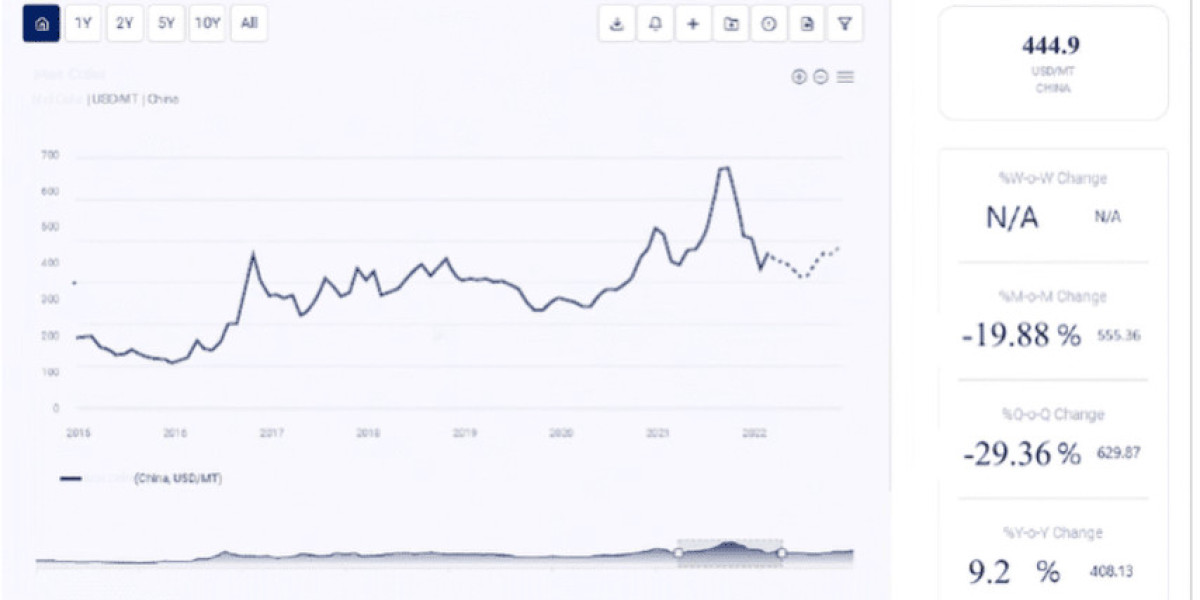2-Ethylhexanol (2-EH) is a versatile organic compound widely used in the production of plasticisers, coatings, and adhesives. Its role in manufacturing and its extensive industrial applications make it a key commodity, and understanding the 2-Ethylhexanol Price Trend is essential for stakeholders across industries. This article delves into the factors influencing 2-EH prices, market dynamics, historical trends, forecasts, and regional insights.
Overview of 2-Ethylhexanol
2-Ethylhexanol is a high-boiling alcohol derived from butyraldehyde through the aldol condensation process. It is primarily used as a raw material for producing dioctyl phthalate (DOP), a commonly used plasticiser, as well as other applications such as:
- Plasticisers: Essential for flexible PVC production.
- Coatings and Paints: Used in solvent formulations.
- Acrylates: Key for adhesives and sealants.
- Lubricants: Acts as an additive to improve performance.
Latest 2-Ethylhexanol Price Trends
The 2-Ethylhexanol Price Trend is influenced by a range of factors, including raw material costs, demand-supply dynamics, and global economic conditions. Recent trends highlight:
Rising Feedstock Prices:
- Butyraldehyde, derived from propylene, is the primary feedstock for 2-EH production. Fluctuations in propylene prices directly impact 2-EH costs.
Supply Chain Disruptions:
- Geopolitical tensions, energy crises, and logistical challenges have caused supply chain inefficiencies, affecting production and distribution.
Demand from Plasticisers Industry:
- The increasing demand for flexible PVC in construction and automotive sectors is driving 2-EH consumption, influencing prices.
Environmental Regulations:
- Stricter regulations on phthalate plasticisers are encouraging manufacturers to explore alternatives, impacting 2-EH demand patterns.
Global Economic Conditions:
- Economic slowdowns in key regions have led to fluctuations in demand, particularly from the construction and automotive sectors.
Enquire For Regular Prices: https://www.procurementresource.com/resource-center/2-eh-price-trends/pricerequest
Market Analysis
The global market for 2-Ethylhexanol is shaped by its applications in high-demand industries. Below is an analysis of key factors:
Demand Drivers
Construction Industry:
- PVC products, such as pipes and flooring, rely heavily on plasticisers made from 2-EH.
- Rapid urbanisation and infrastructure development are driving demand for these products.
Automotive Sector:
- 2-EH is used in coatings, sealants, and automotive lubricants, making it indispensable for this sector.
Adhesives and Sealants:
- Acrylates derived from 2-EH are key components in industrial adhesives and sealants, contributing to its demand.
Supply Constraints
Feedstock Availability:
- Propylene availability and pricing directly impact 2-EH production. Limited feedstock supply can lead to price increases.
Production Costs:
- High energy prices and stringent environmental regulations add to operational costs, influencing market prices.
Geopolitical Factors:
- Disruptions in major production regions due to geopolitical conflicts can lead to supply shortages and price volatility.
Historical Data and Price Forecasts
Historical Price Trends
Over the past decade, 2-Ethylhexanol prices have experienced fluctuations driven by supply-demand imbalances, raw material costs, and global economic shifts. Key trends include:
- 2016-2019: Prices remained stable due to balanced supply and demand, with moderate growth in key sectors.
- 2020-2021: The COVID-19 pandemic disrupted production and demand, leading to price volatility.
- 2022-Present: Rising feedstock prices and supply chain issues have led to significant price increases, particularly in regions like Europe and Asia-Pacific.
Price Forecasts
Short-Term Outlook:
- Prices are expected to remain volatile due to ongoing supply chain disruptions and fluctuating feedstock prices.
- Demand recovery in the construction and automotive sectors may drive price growth.
Long-Term Outlook:
- Investments in renewable feedstocks and advancements in production technology may stabilise prices.
- Rising demand for eco-friendly plasticisers could shift market dynamics, influencing 2-EH consumption patterns.
Database Insights and Chart Representation
Reliable databases tracking 2-EH prices provide valuable insights into market dynamics. These tools include:
Price Indices:
- Detailed charts showcasing historical price movements, regional variations, and current trends.
Supply-Demand Data:
- Comprehensive analysis of production and consumption trends in key industries.
Regional Comparisons:
- Insights into price disparities across regions due to differences in raw material costs, production capacities, and trade policies.
Forecast Models:
- Predictive tools highlighting future price movements based on current market conditions and historical trends.
Market Insights
Shift Towards Sustainable Alternatives
- Environmental concerns and regulatory restrictions on phthalates are driving the demand for non-phthalate plasticisers, impacting the 2-EH market.
Technological Advancements
- Improved production processes, such as energy-efficient reactors and alternative feedstocks, are expected to reduce production costs and enhance sustainability.
Regional Demand Patterns
- Asia-Pacific: Dominates the 2-EH market due to strong demand from construction and automotive sectors. China and India are key contributors.
- North America: Steady growth in the automotive industry and infrastructure projects are driving demand.
- Europe: Environmental regulations and sustainability initiatives are reshaping market dynamics.
Regional Insights
Asia-Pacific
- China: The largest producer and consumer of 2-EH, driven by its robust construction and manufacturing sectors.
- India: Growing infrastructure development and automotive production are boosting demand.
North America
- High demand from automotive and adhesives industries contributes to the region's market strength.
- Investments in advanced production technologies are expected to stabilise supply.
Europe
- Stricter environmental regulations are leading to the adoption of sustainable production practices.
- The region’s demand for eco-friendly plasticisers is influencing market trends.
Middle East and Africa
- Rising industrialisation and infrastructure development are driving demand for 2-EH in construction and automotive applications.
Role of Procurement Resource in 2-Ethylhexanol Price Management
Platforms like Procurement Resource play a critical role in helping businesses navigate the complex 2-EH market. Key benefits include:
Real-Time Price Monitoring:
- Access up-to-date information on 2-EH price trends and market developments.
Comprehensive Market Analysis:
- Gain insights into production costs, regional supply-demand dynamics, and price forecasts.
Cost Optimisation Strategies:
- Identify opportunities to reduce procurement costs and manage supply chain risks.
By leveraging Procurement Resource, businesses can make informed decisions, optimise their supply chains, and maintain competitiveness in the 2-Ethylhexanol market.
Understanding the 2-Ethylhexanol Price Trend is vital for stakeholders to adapt to market fluctuations and seize growth opportunities. With advancements in technology, shifting regulations, and evolving demand patterns, the 2-EH market continues to present dynamic challenges and opportunities. Staying informed about market trends is key to achieving long-term success.
Contact Us:
Company Name: Procurement Resource
Contact Person: Leo Frank
Email: sales@procurementresource.com
Toll-Free Numbers:
- USA & Canada: +1 307 363 1045
- UK: +44 7537171117
- Asia-Pacific (APAC): +91 1203185500
Address: 30 North Gould Street, Sheridan, WY 82801, USA






